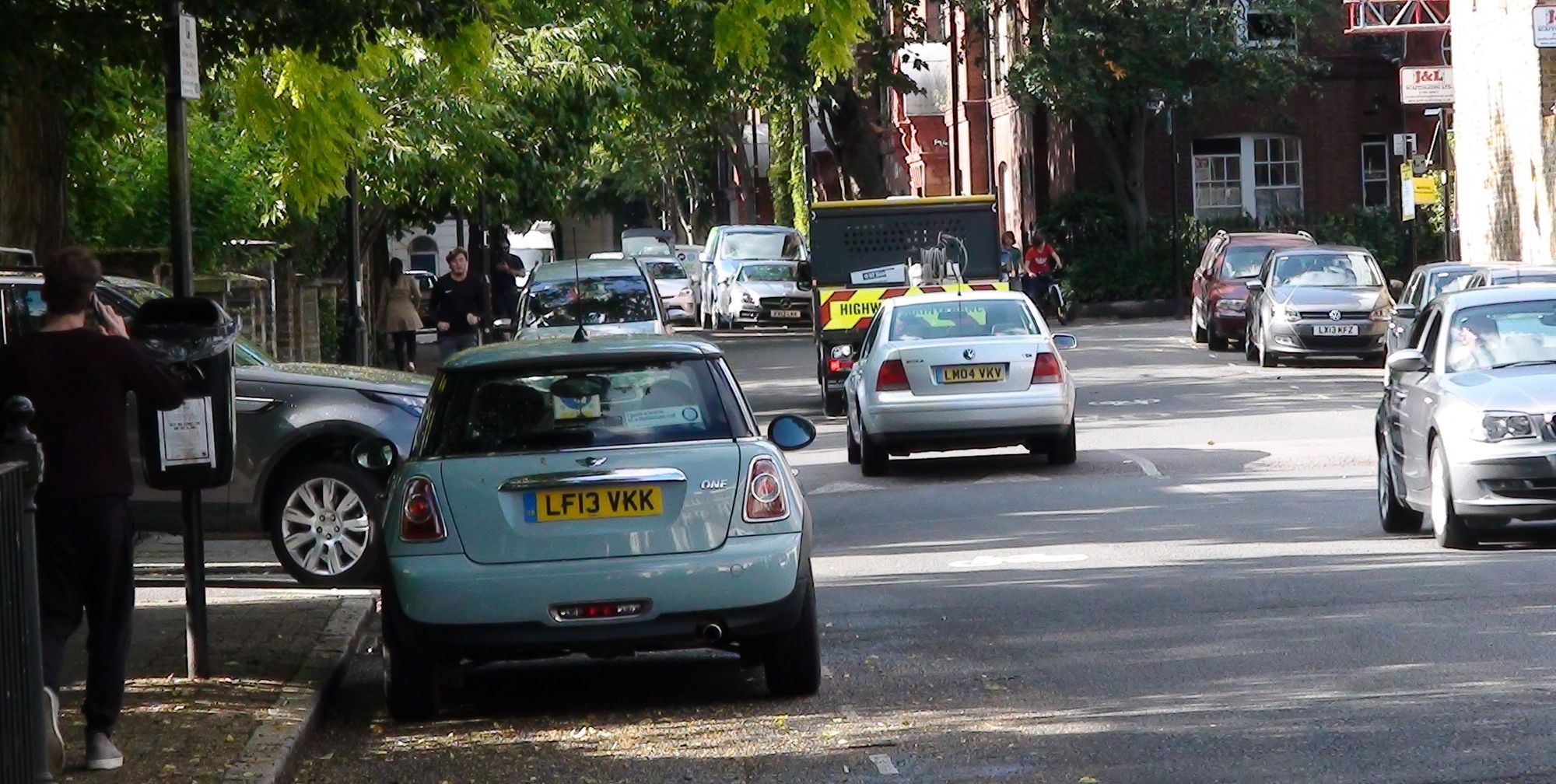Before looking at the impact LTNs have on traffic we must first look at what traffic is like before an LTN is introduced. All over London, with the introduction of GPS over the last decade, the levels of traffic in side roads has increased massively.
The amount of traffic in London streets is unsustainable. We have to reduce the overall levels of traffic, particularly on the side streets where people live and where children should be able to play safely.
Traffic is not an unchanging force of nature. We’ve lived with it for so long that there is a tendency to see it like that, as something we have to put up with, and worse, as something which will go on increasing. But actually traffic responds to changes in the infrastructure provided for it, often in counter-intuitive ways.
Traffic inducement
The concept of “traffic inducement” has been known about for many years. There are many countless examples of this effect and the reason there are so many is because, until recently, most traffic departments operated on a ‘predict and provide’ basis: if more people wanted to drive their cars than the road space would accommodate, then the solution was to build more roads.
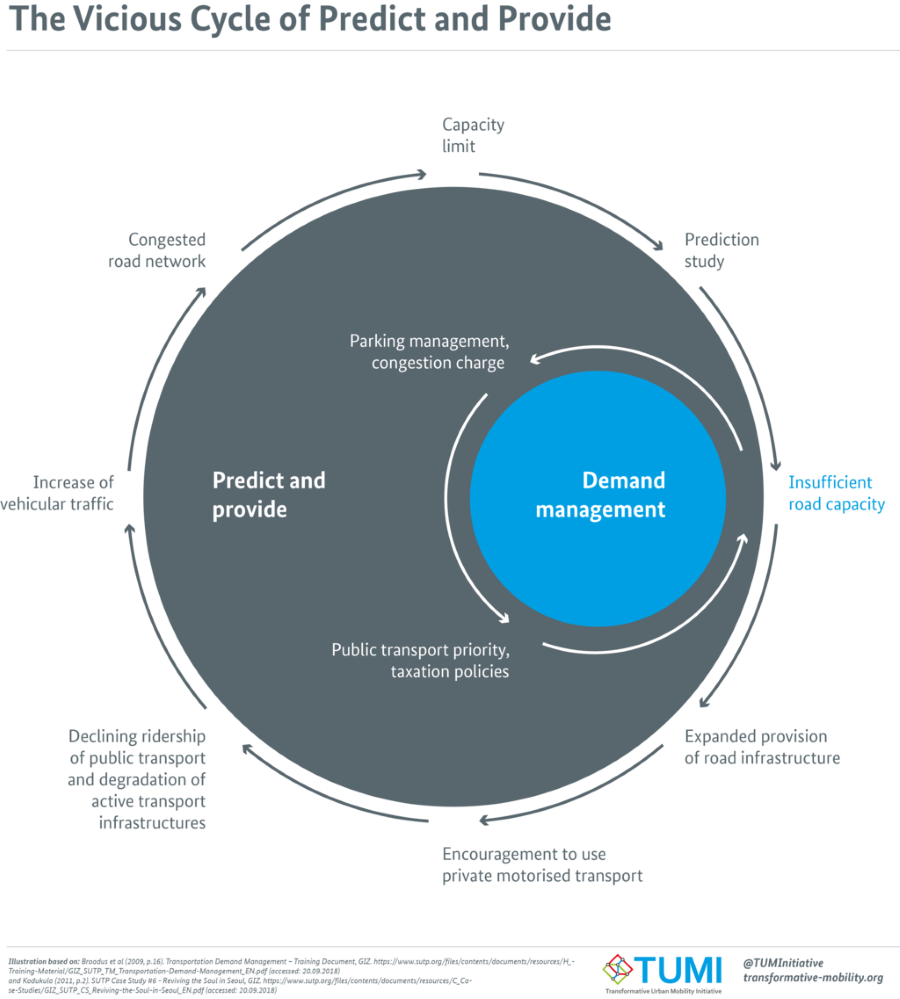
Curbed wrote about research done in America, reported in The Congestion Con, 2020.
… adding one percent more road capacity produces the exact same increase in the amount of vehicle miles travelled.
In Pensacola, Florida, and Omaha, Nebraska—which both saw highways expand three times faster than population growth—congestion increased by 233 and 231 percent, respectively.
And if that’s too American for you, Greenpeace lists a number of British examples, such as:

But just as traffic volumes can go up due to changes made in the infrastructure on which they depend, traffic volumes can also go down, by the same mechanism. One widespread example of road space being restricted is bus lanes. When these were introduced the cars in the two lanes of cars didn’t all just squeeze into one, jammed, lane. Some of the traffic disappeared, enough that traffic kept moving and the city did not grind to a halt.
There is one widely-referenced 1998 Cairns et al, updated in 2002 as 'Disappearing Traffic’, which examined over 70 case studies across many countries.
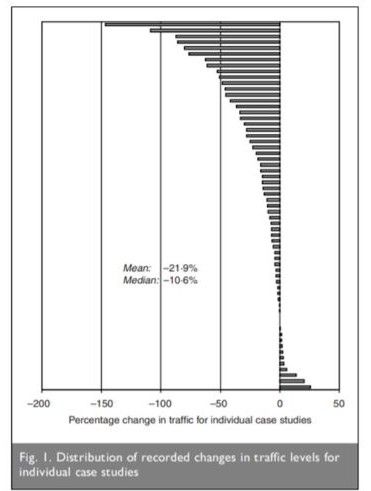
The findings suggest that predictions of traffic problems are often unnecessarily alarmist, and that, given appropriate local circumstances, significant reductions in overall traffic levels can occur, with people making a far wider range of behavioural responses than has traditionally been assumed.
This effect, the reverse of traffic induction, is known as ‘traffic evaporation’. The mechanism by which it works is interesting. Just think of traffic as being, not a single entity, but made up of many individuals, each with their own ability to make their own independent decisions. Remember the old adage: If you are in a vehicle on a road you are not IN traffic - you ARE traffic.
We are all creatures of habit, we make the same journeys repeatedly, and tend to use the same mode each time, without thinking. And once someone owns a car, it will tend to get used for most journeys, with little thought.
TfL’s Roads Task Force paper, “ Why do people travel by car? ” attempts to answer that question, which is not easy because, as the authors report, “mode choice is not something to which drivers tend to have given much thought”. But the authors do have a clear comment on the frequency with which this question is addressed by drivers:
Travel decisions are mostly of a habitual nature and relatively rarely involve serious consideration or examination of alternatives. Evidence from the Car Ownership and Use Research shows that approximately 14 per cent of all trips by drivers involve some thought about which mode of travel to use, with only 4 per cent giving serious thought to this question for any given journey.
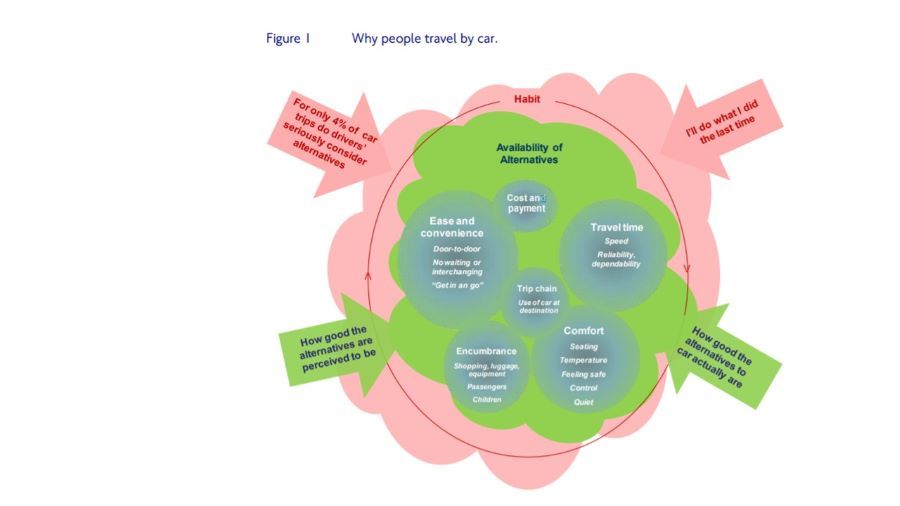
So, for drivers to think about their journeys afresh something has to change. A significant change in the infrastructure available to them will be enough for many drivers to reassess their journey. If they think that journey is going to be more difficult or take longer, they will consider the alternatives. Some people will choose to travel by public transport instead, or walk, or cycle, or re-time the trip, or combine car journeys, or change destinations (shopping local rather than out of town), etc.
Very relevant here is a fact brought out in a 2019 report for Parliament. In England, for distances of 1–2 miles over 60% of journeys were made by motor vehicle. That’s a lot of journeys just crying out to be moved from car to foot or pedal.
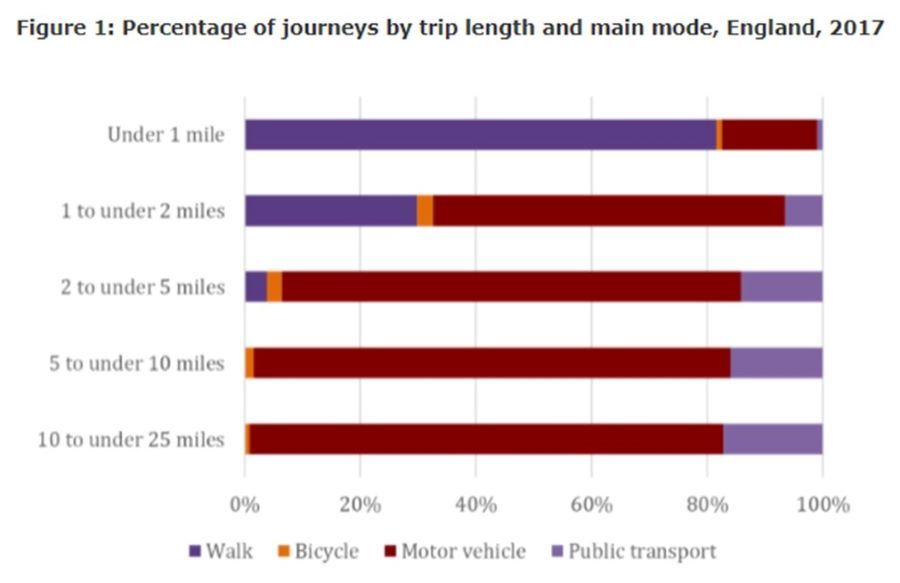
The people who decide to continue in their old mode, and drive, may find that the journey really is now significantly more troublesome and that will cause them to think again the next time that journey is undertaken. This is the mechanism by which traffic reduces when road space is removed. Drivers are not stupid – they do not doggedly go on getting into the car every day knowing that they will sit in traffic jams for an unacceptable amount of time. Over time traffic will reduce to a level that the drivers in it find acceptable.
The International Transport Forum’s 2021 Reversing Car Dependency found that:
The capacity of individual car users to change their travel behaviour in a range of creative ways presents real opportunities for urban planners seeking to optimise the use of space and quality of life in the city.
There is one other possible reason why LTNs tend not to cause congestion on main roads. It’s relatively new research so we treat it with caution, but see “Urban congestion” below.
We haven’t mentioned LTNs for a long time. Let’s return to them. LTNs are a means of reducing the road space available to drivers, so when they are introduced we can expect drivers to re-assess each journey, with the result being that some journeys will no longer be driven. Hence traffic will reduce overall, not just within the LTN but also on the boundary roads.
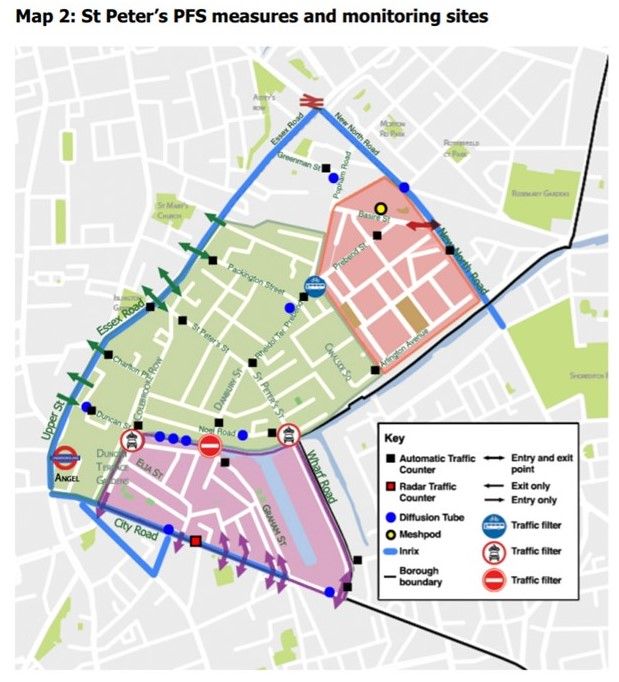
As the recently introduced LTNs are evaluated that is just what is being seen. Again and again, traffic evaporation is being proved, empirically, true: true in Waltham Forest (implemented 2015); true in Hackney (summer 2020); true in Lambeth (June 2020); true in St Peters, Islington (June 2020). In each scheme the average traffic levels on boundary roads have either remained the same or reduced, sometimes significantly. Whilst most individual boundary roads have seen a reduction, not all have. In these cases, where that increase is significant, the Council is investigating further, to identify the problem and introduce measures to correct it.
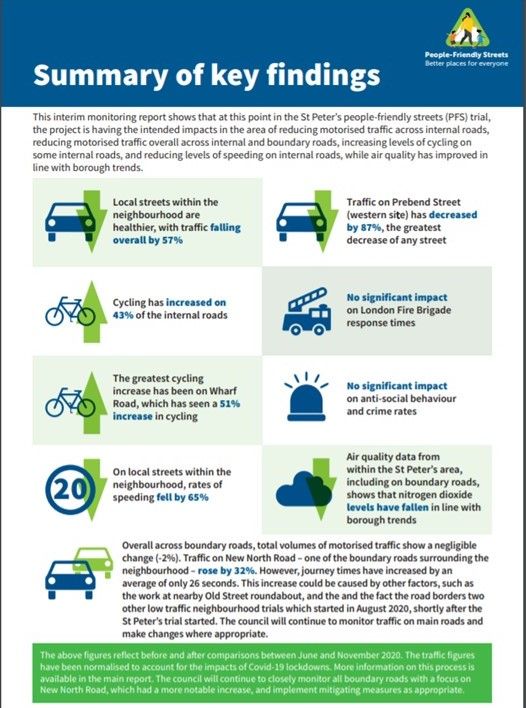
Some of the drivers who decide to (or truly must) continue using their car will find a small percentage increase on some of their journeys as they have to drive further around the edge of a LTN cell before entering.
In summary: When LTNs are introduced there’s often a fear that the surrounding main roads will become gridlocked. People who have not understood about traffic evaporation think that if you restrict access to side streets then all of that traffic will move to the main roads, but, as we have seen, both in theory and in practice, that is not what happens. LTNS are about reducing traffic, not just moving it somewhere else.
Before closing, there are five other points worth noting, that don’t fit in easily anywhere else:
Initial congestion
There is usually a period of about six months as SatNavs update and driver habits adjust. That can cause some extra congestion on nearby main roads in the short term. That is one reason why the Councils do not assess the schemes until they have been in place for a year. So, each time an LTN is implemented, expect angry tweets and letters to the local press from people who do not understand how LTNs work.
Traffic analysis
Counting traffic sounds easy but it’s not a simple science. Background ‘noise’ makes any analysis of traffic counts very difficult. For example, congestion can be caused at one junction by road works at a junction miles away. The pandemic has caused traffic levels to fall massively and then to rise again. There are also longer-term trends which may need to be taken into account. One technique the analysts use to remove some of this noise is to compare a change in levels on the road under study with the change in levels on another similar road.
Remote influence
Each journey, of course, does not end when the vehicle leaves the LTN and its boundary. Some journey will end in the next borough, some may continue much further, even out of London. The benefits of each journey deterred by an Islington LTN will be felt much further afield. And the reverse is true: Islington will benefit from LTN’s implemented elsewhere, particularly so in neighbouring boroughs.
Urban congestion
The Independent reported on the research paper, 'Understanding Congested Travel in Urban Areas':
Rush hour drivers who use short cuts off main roads increase journey times for everybody else, study says - Researchers say the key to clearing congestion is more socially aware routing.
The study itself talks of “selfish routing”. In the London context we take this to mean that each driver that decides to turn off onto a side road in preference to staying on the main road, while reducing their own journey time, is causing delays for the other drivers. Turning out of the traffic and then re-joining it causes disruptions which, when repeated by many drivers will build into significant delays. The authors suggest that persuading drivers to give up their short cuts could cut time wasted in congestion for other drivers by almost a third.
Boundary roads
The strategy behind LTNs results in much-reduced traffic within LTNs and probably a small reduction in traffic on main roads. This is only the beginning. Main roads are where people shop, and wait at bus stops, and walk from the station. Many people live on main roads. These roads also need to be pleasant places to spend time. The campaign continues.
Sources:
DfT report, Road Traffic Statistics, 1993 – 2019
Wikipedia - Elasticity of Transport Demand
Sally Cairns, Carmen Hass-Klau, and Phil Goodwin’s 1998 report ‘Traffic Impact of Highway Capacity Reductions: a review of the evidence’ and 2002 follow-up article Disappearing Traffic
TfL, Roads Task Force - Technical Note 15 - Why do people travel by car?
Active travel: increasing levels of walking and cycling in England, 2019, Parliament.
The International Transport Forum’s 2021 Reversing Car Dependency
Waltham Forest trial results
Hackney trial results
Lambeth trial results
St Peters, Islington trial results
The Independent reported on...
Understanding Congested Travel in Urban Areas, 2016, Serdar Çolak, Antonio Lima & Marta C. González

